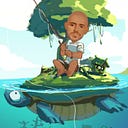The “Lost Parables” of Bible
Hope even for the Coin
I happened to watch a discussion titled ‘Hope for Judas’. It was based on a book titled Hope for Judas written by Christoph Wrembek SJ. The discussion is freely available, though it is worth buying the book too, especially during this Lenten Season. The main question of the book is about one of the most-hated characters in the Bible, Judas Iscariot. As Bible don’t have much mentions about him, the author goes through many of the characters (so-called sinners) in different parables and attempts to read them a little differently. There is much more in the book. Today, I hope to write a little about the three lost-parables (lost sheep, lost coin, lost son) in the gospel of Luke. Christoph gives an added flavour to understand them.
The first mentioned parable among the three is the lost sheep, followed by the lost coin, which is followed by one of the most famous parables of the Bible, that of the prodigal son (or prodigal father as some calls it). Christoph slightly changes the order of the parables to understand the message more powerfully. His order is 1. Lost Son 2. Lost Sheep 3. Lost Coin.
When son is the lost in the first case, it is sheep and coin in the second and third case. Anyone who have studied Aristotelian biology or philosophy could immediately see the hint. Humans are the top of that hierarchy, which is followed by animals, followed by plants and non-living things.
All three were lost. After a certain time, the son came back to his senses. He came back to his father, with a repentant heart. The sheep was also lost. Knowing the geography of Biblical region, the sheep may be lost in one of the hilly areas, from where it can’t return. The only option for it is to cry. Yes, it cries and the good shepherd goes in search of the sheep, which is lost and crying. Interestingly he left the 99 sheeps (or in the protection of guard dogs) to search for the one lost. And in the third parable, the coin is lost. It can’t come back unlike the son. It can’t even cry like the sheep. It is just lost. And the woman (interestingly it is not a man here; probably perseverance is more closely associated with mothers) goes in search of it and finds the coin. Nothing is that lost for God. Nothing is really that sinful for God.
When we read the parables in this order, we can see the love and compassion of the divine father and mother, reaching a new level with each of the parable. God in the image of the prodigal father is already difficult to accept. God in the image of good shepherd is further tricky. God in the image of that women is the hardest to accept. Yet, that is God of Jesus Christ. When Christian church and Christians start projecting this image of God, things can move in an entirely different tangent.
Now probably one question remains, why Christophe changed the order of the parable. Once, he gave a retreat which included a beautiful discourse on the parable of the prodigal son. Then a woman came up and asked him, “what if my daughter never comes back unlike the prodigal son??” Probably a journey of reflection started from there helped Christoph to see the parables in this order and to comprehend the breadth and width of God’s love a much more powerfully.
